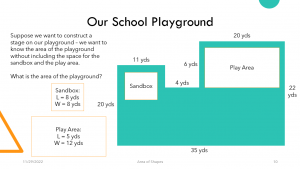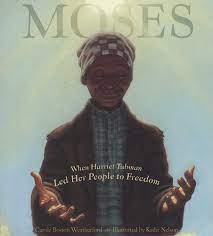What is InTASC Standard #5: Application of Content
The purpose of InTASC Standard #5 is to guide teachers to foster skills beyond memorization and standard procedures. Students apply content knowledge when they make connections between concepts and practice 21st century skills, such as creativity, collaboration, and critical thinking. Finally, the application of content creates the mindset to solve an authentic local or global problem. The significance of InTASC Standard #5 is that it creates meaningful learning experiences that will serve student growth throughout their academic career and into their lives beyond schooling. To demonstrate my understanding of InTASC Standard #5, my artifacts include a math mini-project on area; a series of read-aloud stories for a Civil War unit; and a Yellowstone Park extension activity for an ecosystems unit.
Artifacts for InTASC Standard #5
Area of Our School’s Playground
After understanding the basic concept of area, practicing the methods of finding the area of a rectangle, and diving into the question of units squared, students are ready to solve a multi-step story problem that places the concept of area into a real-world context. As a class, the students determine the area of the school’s playground and add their own structures to create their ideal playground. This mini-project represents InTASC Standard #5 because the application is relevant to students’ daily lives and it involves critical thinking skills, which students exercise as they practice different ways to find the area of an unfamiliar shape. Also, students blend math with creativity to make their own designs for the playground.

The photo captures the central problem-solving activity in this unit on the area of a rectangle. The problem involves several steps, including multiplication, addition, and subtraction.
VA Studies Read-Alouds
Students blend reading and VA studies instruction throughout their unit on the Civil War in Virginia. In their reading curriculum, students are learning about how a character’s perspective informs their actions in a story and how to incorporate sensory details into their writing. Students will extend their understanding of these concepts in their Civil War unit as they read Moses: When Harriet Tubman Led Her People to Freedom. Before they read, students identify three perspectives on slavery during the Civil War era: northern abolitionists, southern pro-slavery plantation owners, and enslaved peoples. During reading, students will think about how Harriet Tubman’s perspective on slavery led to her incredible bravery and risky actions to lead others to freedom. Finally, the students finish reading by skimming the text for sensory details. This blend of reading, writing, and VA studies represents the cross-disciplinary goals of InTASC Standard #5. The lesson engages students in critical thinking as they make connections between history content knowledge and their ideas about perspectives and actions, which lifts the barrier between disciplines as students discover how they can use details and evidence in their own writing. Secondly, students are also using their creative skills to generate their own sensory details as they gain more exposure to examples across literary and historical genres.

Yellowstone Wolves Investigation
In their unit on ecosystems, students learn about concepts such as populations and communities, producers and consumers, food webs and energy pyramids, and even more. In my two-week lesson plan, I created a science investigation that blends writing and research skills for students who achieve beyond the target lesson objectives. In this investigation, students will learn about the reintroduction of wolves to Yellowstone National Park and its effects on the ecosystem. To explore the issues surrounding the wolves of Yellowstone, students will extend their knowledge of ecosystems to research the ways that humans can make positive or negative changes to the environment. The objective of this research is to build environmental consciousness and think about environmental action. The students will learn that over-hunting wolves led to the disastrous effects in Yellowstone, and they will create a poster that advertises ways that humans help or hurt their local environment. This investigation reflects InTASC Standard #5 because it promotes research skills, critical thinking, and informed action to protect local ecosystems, an issue that is increasingly important for the younger generation. This investigation aims to create relevant and meaningful experiences that foster good citizenship habits beyond school.
This link leads to the “Wolves of Yellowstone” video by National Geographic, which is the focus activity for the unit. Students revisit this video to understand how human impact led to this environmental disaster.